The publication of Copernicus’ De revolutionibus orbium coelestium started a ”Copernican Revolution.” It was a paradigm shift from the Ptolemaic model of the heavens, which described the cosmos as having Earth stationary at the center of the universe, to the heliocentric model with the Sun at the center of the Solar System. The helicoentic theory inspired many scholars who contributed to the Copernicus’ model of the universe.
 |
| Motion of Sun (yellow), Earth (blue), and Mars (red) according to heliocentrism (left) and to geocentrism (right), before the Copernican Revolution. |
A Danish nobleman and astronomer Tycho Brache admired Copernicus’ work especially for his mathematical solutions. Although Tycho appreciated the advantages of Copernicus's system, he could not accept the movement of the Earth and settled on geoheliocentrism, meaning the Sun moved around the Earth while the planets orbited the Sun. The King of Denmark gave Tycho Brahe an Island Hven, where he established an observatory called Uraniborg. When Tycho died unexpectedly his assistant Johann Kepler continued his work.

Johannes Kepler was a great supporter of Copernicus’ ideas. In his first book The Mysterium Cosmographicum he openly endorsed Copernican cosmology. Kepler like Copernicus, asserted the physical reality of a heliocentric model as opposed to a geocentric one. Yet, despite all of his breakthroughs, Kepler could not explain the physics that would keep a planet in its elliptical orbit. He was also the author of Kepler's Laws, describing the motion of planets around the Sun. You should remember the laws from your physics lessons at school. 😃
Galileo Galilei was an Italian scientist who is sometimes referred to as the "father of modern observational astronomy". Galileo Galilei came after Kepler and developed his own telescope. It allowed him to study Venus and discover that it has phases like a moon. The discovery of the phases of Venus was one of the more influential reasons for the transition from geocentrism to heliocentrism. The idea of a heliocentric solar system was so controversial that the Catholic Church classified it as a heresy, and warned the Italian astronomer Galileo Galilei to abandon it. The Inquisition forced Galileo to say he was wrong— that the Earth did not revolve around the sun. Galileo had made the proclamation in his book Dialogue Concerning the Two Chief World Systems. Legend has it that after he recanted his views, Galileo muttered, “And yet it moves,” under his breath. However, there’s no historical basis for that claim.
 Isaac Newton was a well known English physicist and mathematician. He was a main figure in the Scientific Revolution for his laws of motion and universal gravitation. The laws of Newton are said to be the ending point of the Copernican Revolution. Newton was eventually able to show that gravity was responsible for the orbital motions of all of the planets in the solar system, prompting him to name it "universal gravitation". By applying his theories regarding gravitational forces, Newton was able to derive Keppler's three laws of planetary motion mathematically, removing any lingering doubts about the validity of a heliocentric model of the solar system.
Isaac Newton was a well known English physicist and mathematician. He was a main figure in the Scientific Revolution for his laws of motion and universal gravitation. The laws of Newton are said to be the ending point of the Copernican Revolution. Newton was eventually able to show that gravity was responsible for the orbital motions of all of the planets in the solar system, prompting him to name it "universal gravitation". By applying his theories regarding gravitational forces, Newton was able to derive Keppler's three laws of planetary motion mathematically, removing any lingering doubts about the validity of a heliocentric model of the solar system.
Galileo Galilei was an Italian scientist who is sometimes referred to as the "father of modern observational astronomy". Galileo Galilei came after Kepler and developed his own telescope. It allowed him to study Venus and discover that it has phases like a moon. The discovery of the phases of Venus was one of the more influential reasons for the transition from geocentrism to heliocentrism. The idea of a heliocentric solar system was so controversial that the Catholic Church classified it as a heresy, and warned the Italian astronomer Galileo Galilei to abandon it. The Inquisition forced Galileo to say he was wrong— that the Earth did not revolve around the sun. Galileo had made the proclamation in his book Dialogue Concerning the Two Chief World Systems. Legend has it that after he recanted his views, Galileo muttered, “And yet it moves,” under his breath. However, there’s no historical basis for that claim.






Brak komentarzy:
Nowe komentarze są niedozwolone.